10 Tips To Traveling Vegan in Korea: A Comprehensive Guide.
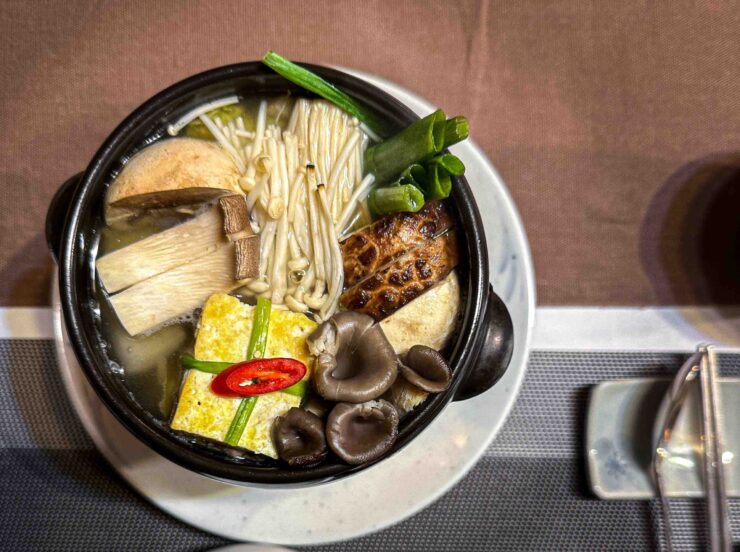
Vegan in Korea-2024 Edition.
If you’ve been reading my newsletter, you already know that I spent the first half of June 2024 in South Korea with my family. It was my second time back to Korea since going vegan (I was there in 2019 to collect stories for my book) and while a lot has changed, bottom line:
It’s still pretty challenging to travel as a vegan in Korea.
Here are some of the highlights of what we’ll cover in this article:
- Background of veganism in Korea
- How to tell people you’re vegan in Korea
- Foods that are usually vegan in Korea
- Foods that seem vegan but usually are not vegan in Korea
- Some of our favorite restaurants with vegan food in Korea
So, without further ado, let’s get into it!
Veganism in Korea–A Rising Tide.
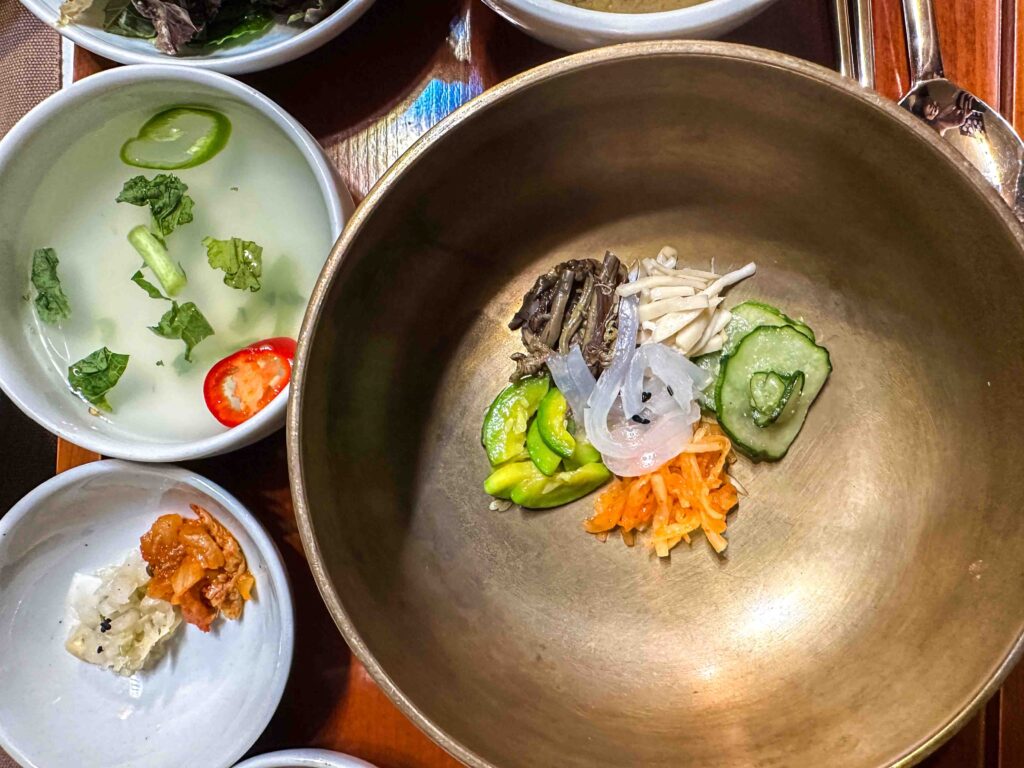
In 2008, roughly 150,000 people in South Korea were eating a vegan diet. (See Statista.) At that time, there wasn’t even a word in Korean for “vegan.” I know this because when I went vegan in 2016 and asked my parents for the Korean translation, they shrugged and said, “Maybe chaeshik? Although, that’s more vegetarian…”
As of 2021, there were approximately 2.5 million people in Korea following a vegan diet. (Id.) This represents a staggering 1,556% increase in the past 13 years. Put another way, “[t]he number of vegans has increased tenfold from 2008 to 2018, and has shown a growth of around 67 percent in the three years after that.” (Id.)
Why the explosion of interest in veganism? According to one survey, the majority of respondents identified “health management” as their reason for following a plant-based diet. The second reason was for “weight loss.” These responses mirror the more popular rationales for going vegan here in the United States: preventing chronic illness and losing weight.
But in contrast with veganism in the US, veganism in Korea has long, historical roots in Buddhism. Indeed, I think this is one of the reasons there wasn’t really a word for “vegan” until more recently. At one point in Korea’s history, the majority of its people practiced Buddhism. Moreover, meat was a scarce resource for a relatively poor nation. As a result, eating less or no meat was just a way of eating that was taken for granted.
Interestingly, there’s far less stigma attached to the word “vegan” in Korea than in the United States. No one will look down on you or treat you with the hostility born out of the discomfort of projected guilt that so many vegans experience in Western cultures, which, albeit, hasn’t had the benefit of a millennium to get comfortable with the idea of compassionate eating.
Now, eating like a Buddhist monk or nun doesn’t necessarily equate to eating vegan. Like the priest who smokes or drinks, there are some Buddhist practitioners who blur the lines when it comes to what they can or cannot put into their bodies. But as I talk about in my book, when I visited Jeong Kwan seunnim, a Buddhist nun most famous for being featured in Season 3 of Chef’s Table, she explained to me that eating vegan is the way many people have eaten in Korea for a thousand years. “Vegan, not vegan–what does this word matter? This is just the way we’ve always eaten.” There simply wasn’t any need for a word that described something so basic.
But as the number of strict Buddhists who adhered to a plant-based and allium-free diet continued to shrink over the centuries–particularly with the introduction of Christianity, followed closely on its heels by capitalism (funny how those things seem to go hand-in-hand…)–the exclusion of animal-products from one’s diet described far fewer people than it once did and a Western iteration of veganism ultimately took root in modern Korean society.
How To Tell People You’re Vegan in Korea.
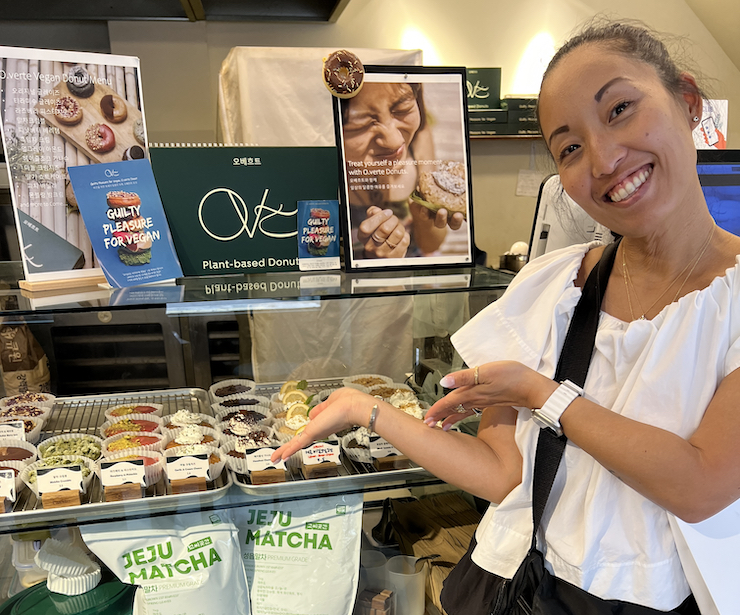
Probably due to the astronomical growth in plant-based eating in Korea, there is now a word for vegan in Korea: “bee-guhn.” It’s essentially just a phonetic transposition of “vegan.” That’s the good news. The other good news is that many people understand at least some English in Korea, particularly if they’re in the hospitality industry (hotels, restaurants, etc.)
Bad news? Many people still don’t know what that means.
I travel a lot for work–usually domestically. I frequently order room-service for breakfast and I’d say about 30% of the time, when I tell the person on the phone that I’m “vegan,” they quite obviously don’t know what I mean by that (“well, we have some delicious buttermilk pancakes!”). I remember when my legal assistant waltzed into my office with a beautiful cupcake for my birthday, saying, “I think you can eat them.” I thanked her but knew instantly, from the label, that she’d confused “vegan” with “gluten-free.”
This sort of confusion occurs much more frequently in Korea. I would say the majority of the time, unless you’re in a fancy hotel, when you utter the word “bee-guhn,” they will assume you mean vegetarian or pescatarian. If you’re lucky, they’ll ask whether you can eat dairy, eggs, or fish (this was our experience, for example, on Korean Air–our lovely flight attendant asked us a couple times whether our “vegan diet” allowed for fish).
Accordingly, most of the time, simply telling the server, restaurant owner, or room-service person that you’re “bee-guhn” is not going to cut it as a vegan in Korea. In addition to that, you’ll have to tell them, “no fish, no dairy, no eggs.”
How do you say that in Korean?
- “Without fish”: sehng-sun-yoo up-kkeh
- “Without dairy”: oo-yoo up-kkeh
- “Without eggs”: gyeh-rrahn up-kkeh
You can also just right-click on the image below, save it onto your phone, and hand your phone to whomever you’re trying to explain this to if they don’t speak English:
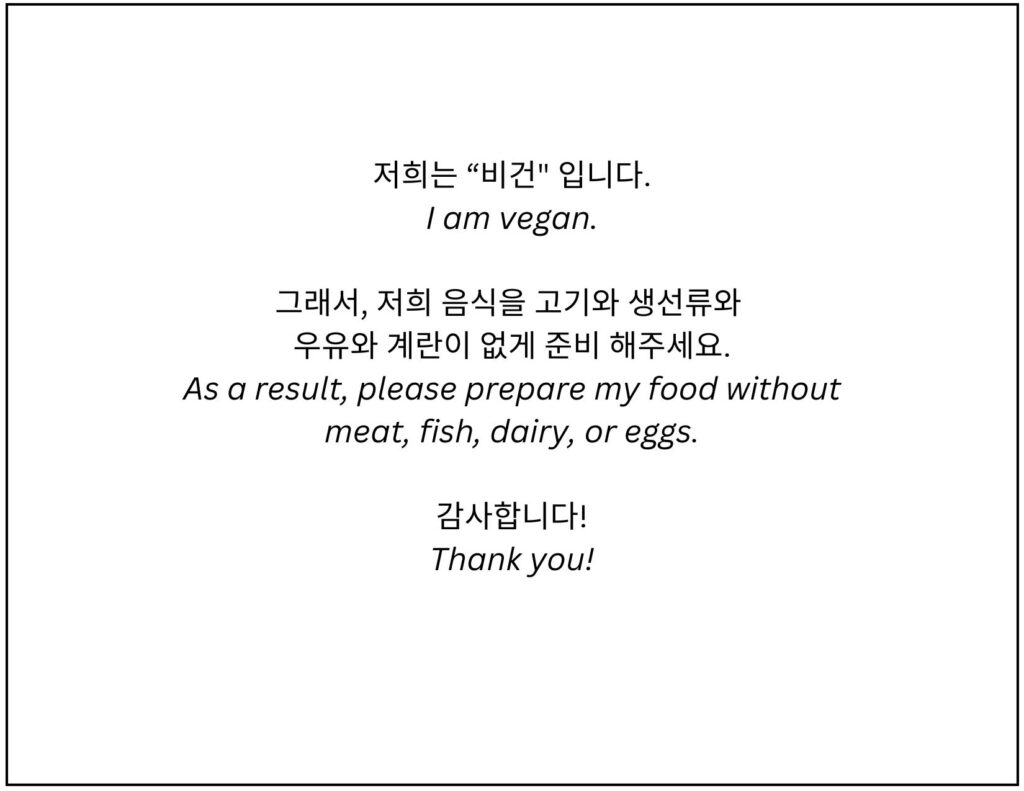
Finding Foods That Are Vegan In Korea.
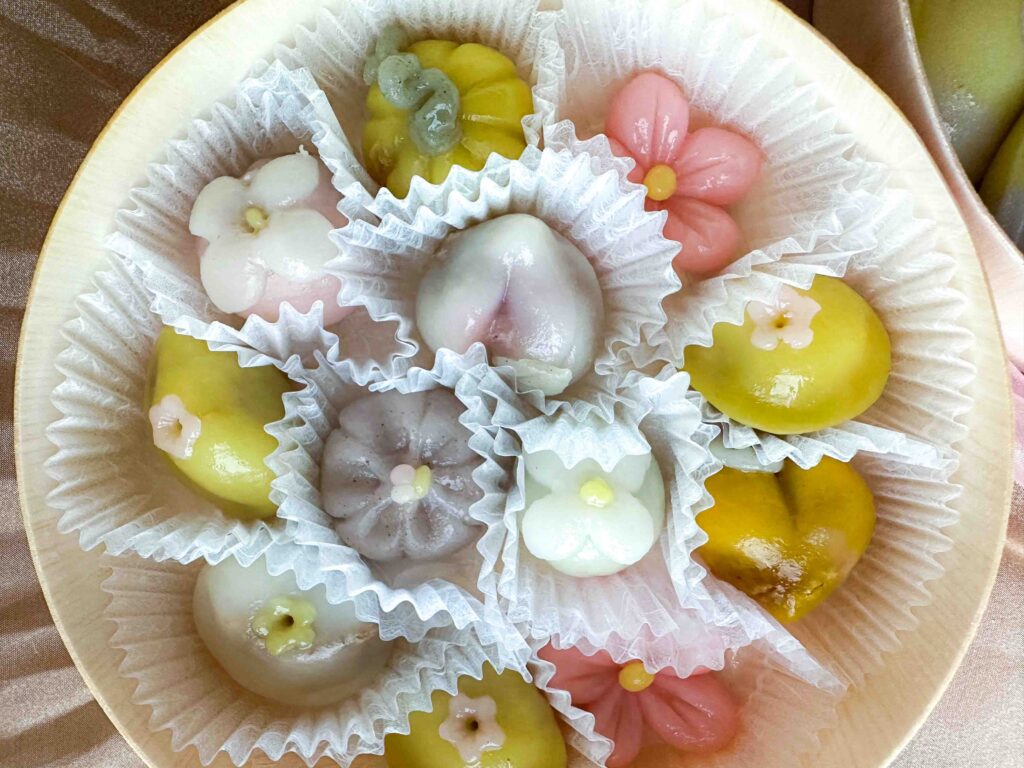
Let’s start this section with good news–there are now a lot more vegan restaurants in Korea than there were even just 5 years ago. For instance, HappyCow (an app that identifies potentially vegan-friendly spots) lists 781 reviewed restaurants, bakeries, cafes, or grocery stores in just Seoul. Accordingly, it’s much easier than it used to be to find readily self-identified vegan eateries. Now, you have to take this with a grain of salt–many of the restaurants listed in HappyCow have terrible reviews for either not having many options, or not having any at all, in some cases.
The popularity of veganism has trickled into menus, as well–you’ll find “vegan” or “v” next to items on both menus or at a buffet (e.g., our hotel’s breakfast buffet clearly labeled items as “vegan” when appropriate).
Another great way to find vegan options that aren’t necessarily on Google or HappyCow is to download Korea’s version of Google, Naver, and copy/paste “비건” into the Naver Map search bar. This will yield far more results than even HappyCow, though, again, there’s no guarantee that the vegan options will be good or even, well, actually vegan.
The bad news is that, without labels, there are very very few foods in Korea that you can bank on being vegan, no questions asked. In fact, I can only think of a few:
- Sweet Ricecakes or Tteok. Traditional ricecakes or “tteok” are made out of rice, salt, and water. Sweeter ricecakes are often stuffed or coated with other natural ingredients, like fruit, red bean, or ground mugwort. Some do contain honey so beware of that! Otherwise, the majority of sweet ricecakes are not only vegan, but also gluten-free. You can find tteok in traditional Korean bakeries–not the Paris Baguette dotting every corner of every block in Seoul, or the cafe featuring all those beautiful little cakes in their glass display. Traditional Korean bakeries are referred to as “tteok jip” or “ricecake house.”
- Cold Soybean Noodles or Kong Guksu. My father insisted on taking me out to a kong gusku jip or cold soybean noodle restaurant on our very last day in Korea. The noodles themselves consist of wheat, salt, and water. The broth they come in is made out of soybeans, salt, sesame seeds, and pine nuts (if they wanna get fancy). You can actually find a recipe for my own version of kong guksu here. There are a lot of traditional restaurants in Korea that serve kong guksu that do not have any idea what “vegan” means. In fact, kong guksu is such a popular item in summer, there are restaurants that are famous for serving little else. BUT, word to the wise: as you’ll see below, all the accoutrements that come with your entirely plant-based bowl of noodles will likely not be vegan.
- Rice Porridge or Jook. I love rice porridge or jook. Jook is quite prevalent in Korea and many versions are “accidentally” vegan. Plain rice porridge, pumpkin rice porridge (hobbahk jook), and red bean rice porridge (paht jook) are three very popular varieties that are all vegan and gluten-free. Our breakfast buffet had a whole section of different rice porridges, all of which were vegan.
- Some Korean Street Foods. Most Korean street food is not vegan. However, in winter, you can find roasted sweet potatoes, roasted chestnuts, and even hotteok or fried, stuffed pancakes–all of which are traditionally made without animal products.
Foods To Avoid Or Ask Whether They’re Vegan In Korea.
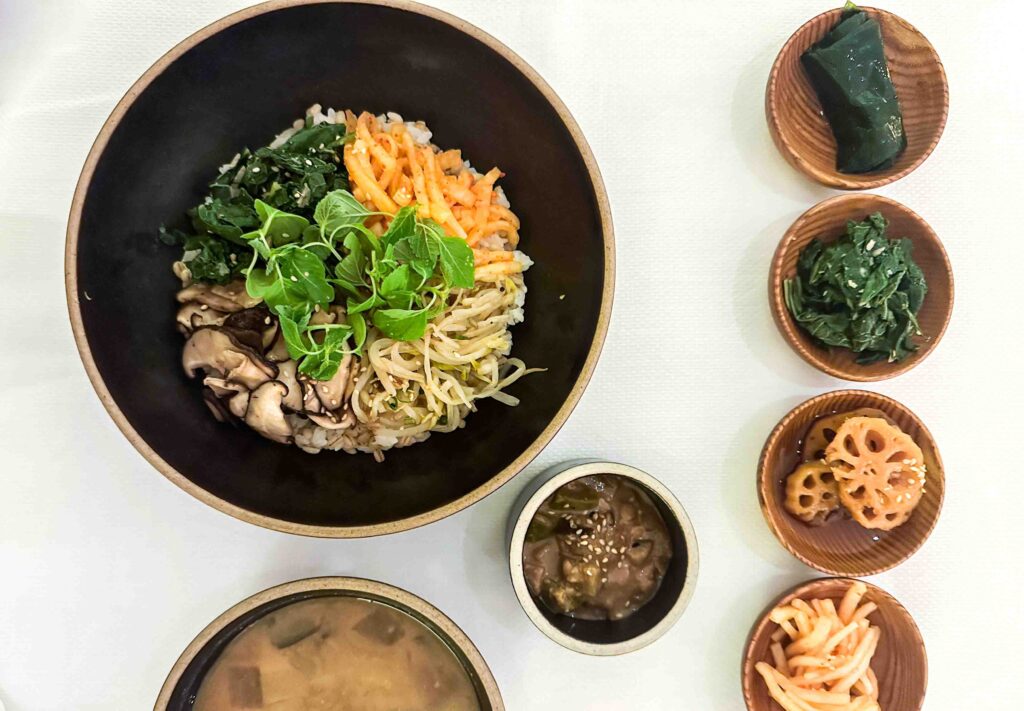
The overwhelming majority of food in Korea is not vegan. You might find this surprising since so much of it looks vegan. So many vegetables, roots, starches! So many soups and stews without a morsel of meat in sight! So many bakeries with ciabatta, baguettes, and bagels! Surely, South Korea is a bevy of plant-based fare!
Alas, this would be true except for the fact that Korea is a peninsula. And therefore, they like to add fish sauce, shrimp paste, or anchovy broth into almost every savory dish in their lineup. AND, for whatever reason, the majority of modern bakeries in Korea have adopted the “butter and eggs make everything taste better” line of thinking when it comes to even those baked goods that are not traditionally enriched (e.g., the aforementioned baguette). Therefore, eating vegan in Korea is sort of like navigating a mine-field–it looks ok, but ya just never know.
The following are some common Korean foods that look vegan but are probably not:
- Kimchi. Kimchi will not show any signs of animal products (unless you look really close up), but will almost certainly contain fish sauce and shrimp paste. Unless you go to a vegan restaurant, you’re unlikely to find any vegan kimchi. Check out my vegan kimchi recipe!!
- Banchan in general. I call out kimchi specifically (because of its popularity), but honestly, none of the banchan or assortment of “side dishes” that typically attend a traditional Korean meal are likely to be vegan. The vast majority if not all of these small veg-friendly looking items are probably seasoned with fish sauce. Because these small side dishes are mass made in advance (not made to order), they will not have fish-free versions available. You can ask whether any of them have been made without fish sauce or anchovies, but not only will this require some nuanced Korean, depending on the restaurant, I’m honestly not confident you can trust the reply… Check out 5 vegan banchan with zucchini!
- Bibimbap. Often touted as the “safe” vegan option at most Korean restaurants, the truth is… it isn’t. By definition, “bibimbap” translates into “mixed rice” and aims to serve as the “empty-the-fridge” dish that you put together when you’re too tired to do much cooking. Hence, the rice is mixed with pre-made banchan, i.e., the stuff I just described as being prepared with fish sauce and anchovies. Unless you’re at a vegan/vegetarian restaurant or the menu specifically calls it out as vegetarian, there’s a good shot that this “safe option” isn’t what you think it is… Again, feel free to ask your server or the restaurant owner whether their bibimbap is made using any vegetables that were seasoned without fish sauce. You might get lucky!
- Soups and Stews. Even the most innocuous looking vegetable laden soybean stew or doenjang jjigae will likely be made with beef broth, pork broth, or anchovy broth. If you want a vegan soup or stew, ask for a “chaeshik” or vegetarian version–most people are familiar enough with this word to understand you’re looking for something prepared without anchovy broth. Check out my hi-protein vegan kimchi-jjigae!
- Most Korean Street Foods. Look, I know you’re literally planning your entire trip around eating tteokbokki with toothpicks like they do in all the Korean dramas, but I got bad news: the vast majority of Korean street food, including the viral spicy ricecakes, are not vegan. Specifically, tteokbokki is often simmered in anchovy broth and/or paired with odeng (fishcakes). Kimbap, another popular Korean street food, usually contains pork, beef, or fishcakes, as well. You can try asking for vegetable kimbap or “yah-chae kimbap”–these are growing more and more popular. Check out my 15-minute vegan tteokbokki!
- Korean Pancakes or Jeon. Not only will most Korean pancakes contain pork, mussels, shrimp, and/or fishcakes, the batter for even the plain-Jane vegetable pancakes is often prepared using fish sauce, anchovy broth, and/or eggs. Check out my gluten-free Korean pancake recipe!
- Most Noodle Dishes. With the exception of kong guksu (see above), virtually all noodle dishes will contain meat or seafood in either the sauce or the broth. Check out my vegan cold kimchi noodles recipe!
Restaurants with Vegan Food in Korea.
The following are restaurants we can personally vouch for as having quality options that we thoroughly enjoyed as a vegan in Korea:
Vegan/Vegetarian.
- Plant Cafe. We visited Plant Cafe back in 2019. They are an OG vegan eatery in Korea, now with two locations (both Itaewon and Yeonnamdong). Mostly American fare, with some fusion-y items.
- Overte Donuts. With the indefinite closure of my favorite all-vegan bakery, Bread Blue, I was anxious to find a replacement. While I prefer French pastries, I also LOVE donuts and Overte definitely hit that sweet spot. They had really delicious and imaginative varieties, like lemon basil, green tea, and tiramisu. They also have beautiful espresso beverages!
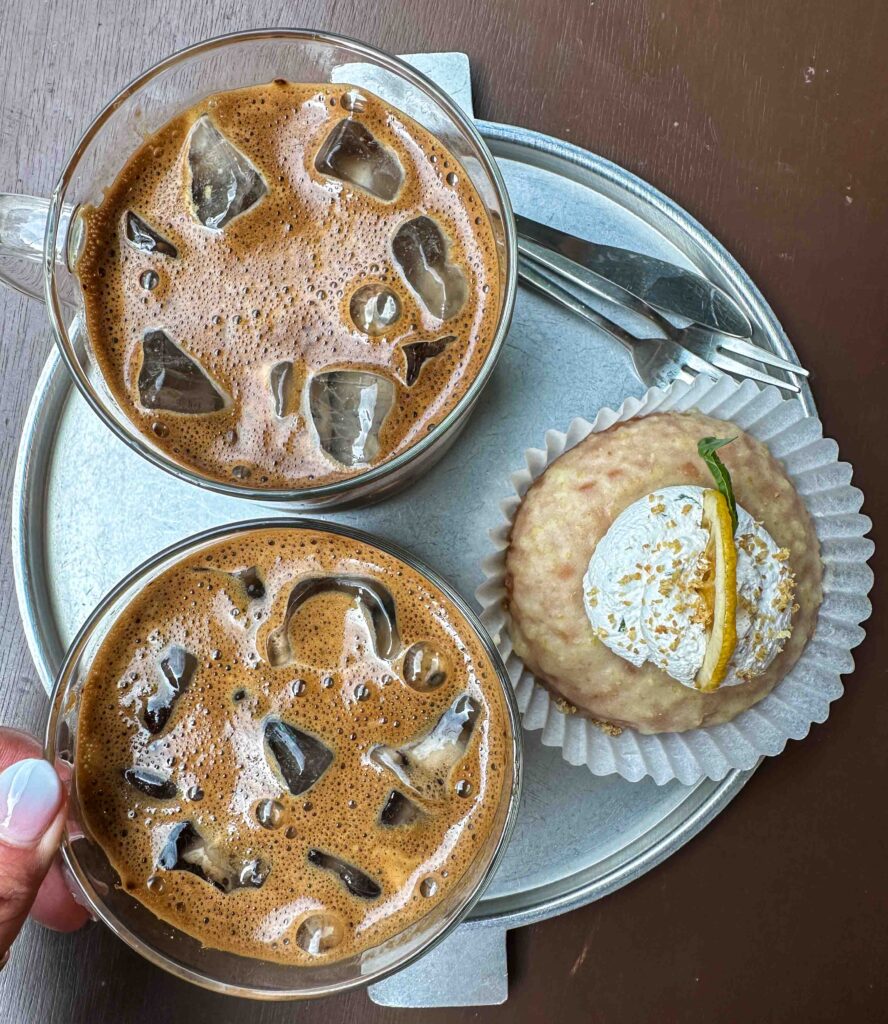
- Hangwachae. This place is going to look sketch–it’s located in what appears to be a basement. It’s cafeteria style and I LOVED IT. This is very traditional Korean food that is prepared plant-based, borrowing heavily from temple cuisine. You’ll find all the banchan you couldn’t eat while your non-vegan friends were chowing down, and then some!
- Balwoo. If you want traditional temple food, Balwoo is a must-visit. The food is so beautifully prepared, you’ll feel like you’re inside a palace.
- Loving Hut – Jeju. Loving Hut was our little miracle in Jejudo. The owner/cook prepares the food with a lot of love and it’s delicious. The food here will be mostly Korean (my plate came with a few french fries!!) and locally sourced.
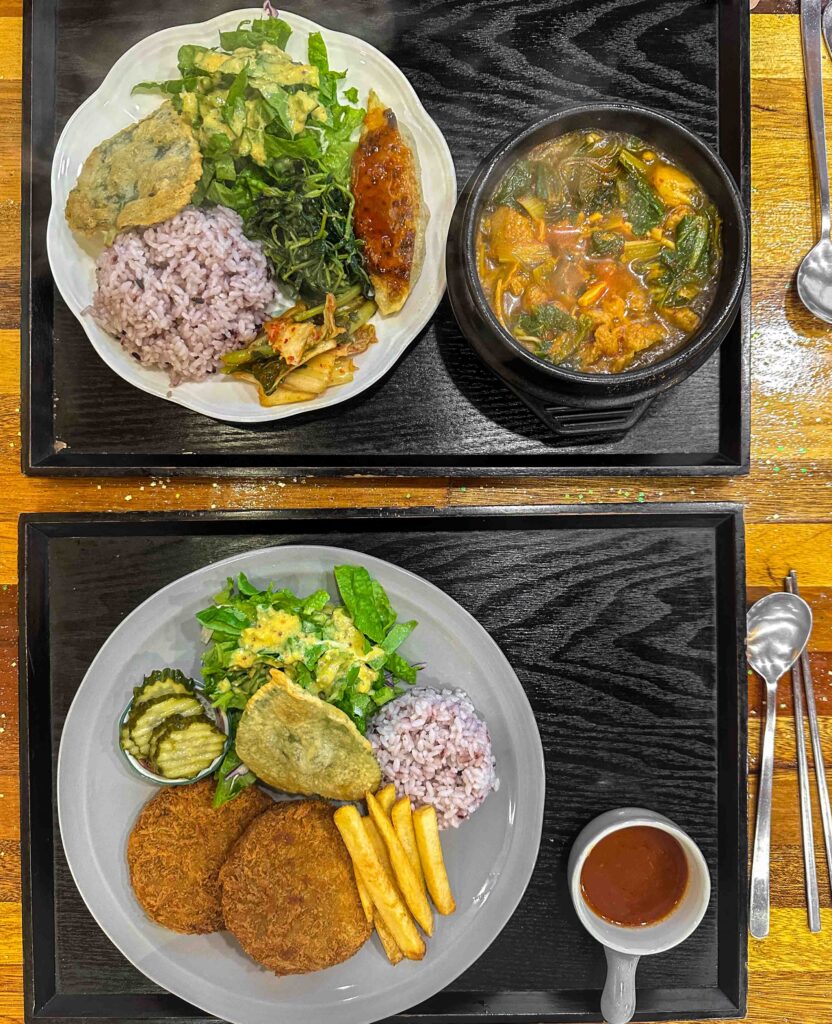
Vegan Options.
- The Market Kitchen by The Four Seasons. Lucky for us, our hotel rate came with free breakfast every morning. The breakfast buffet at The Four Seasons is hands down the best breakfast I’ve ever had in my life. They have a ton of fresh, unenriched (i.e., no butter or eggs) baked breads, rice porridges, roasted vegetables, vegan dumplings, vegan kimbap, and a ton of vegan banchan–all clearly marked as such. I ate like royalty every morning in Seoul.
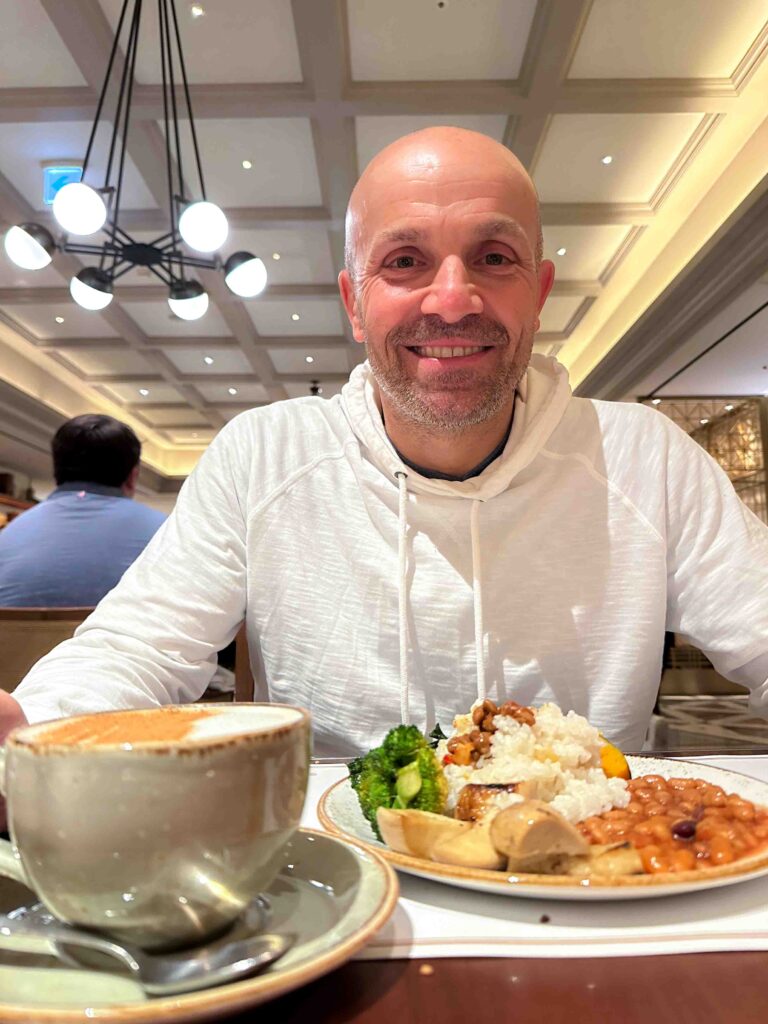
- Maru Lounge by The Four Seasons. I also LOVED the lounge food at The Four Seasons. We were delighted to discover a full vegan menu the server fished out of his back pocket when we informed him we were vegan. It included vegan bibimbap, vegan bulgogi (Korean BBQ), vegan galbi tteok (Korean braised short ribs), and a vegan burger.
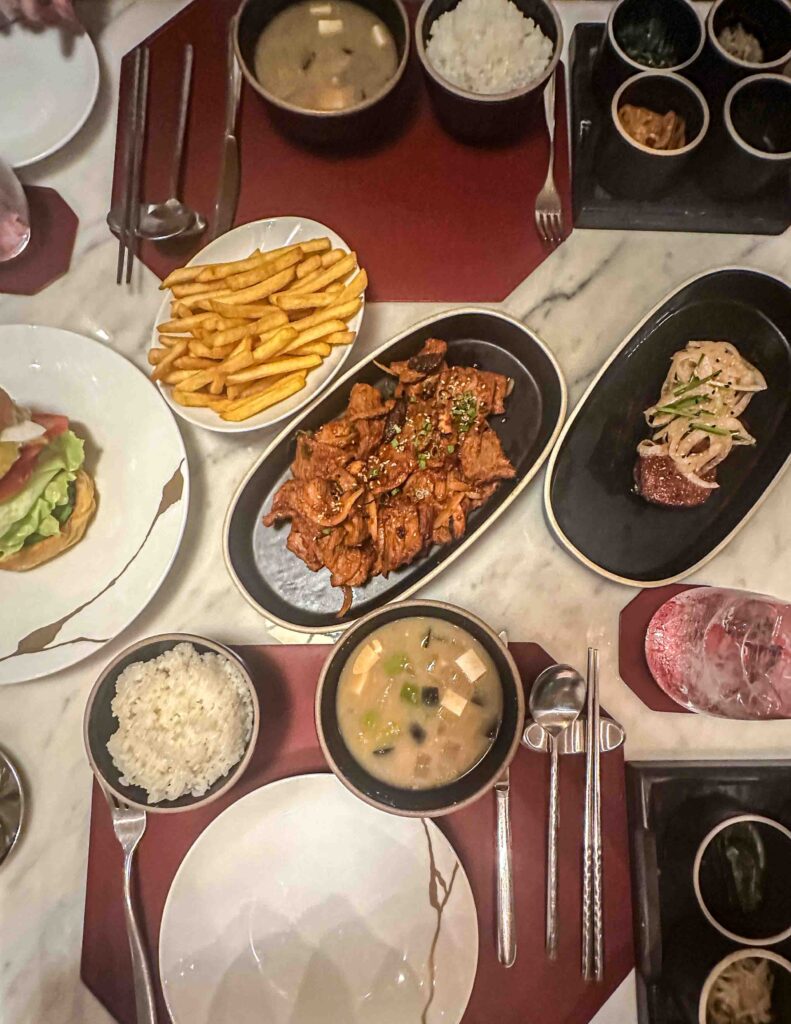
- Garden Terrace by The Four Seasons. In the summer, the hotel will also open their Garden Terrace–an outdoor cafe that overlooks the city. Amazingly, the menu featured a vegan burger made out of tofu! Bring your friends, client, or just wander up their yourself one fine summer evening–enjoy a cool beverage, some delicious vegan eats, and a beautiful view!
- Leedorim Cafe. Undoubtedly one of my favorite discoveries in Seoul was Leedorim (thanks to my friend Won-suk). Not only is it a cool, gorgeous cafe that feels more like an art installation than a food spot, half of its baked goodies are vegan!!! And let me tell you, you will NOT find vegan croissants and tartlets that taste this good in the US!!
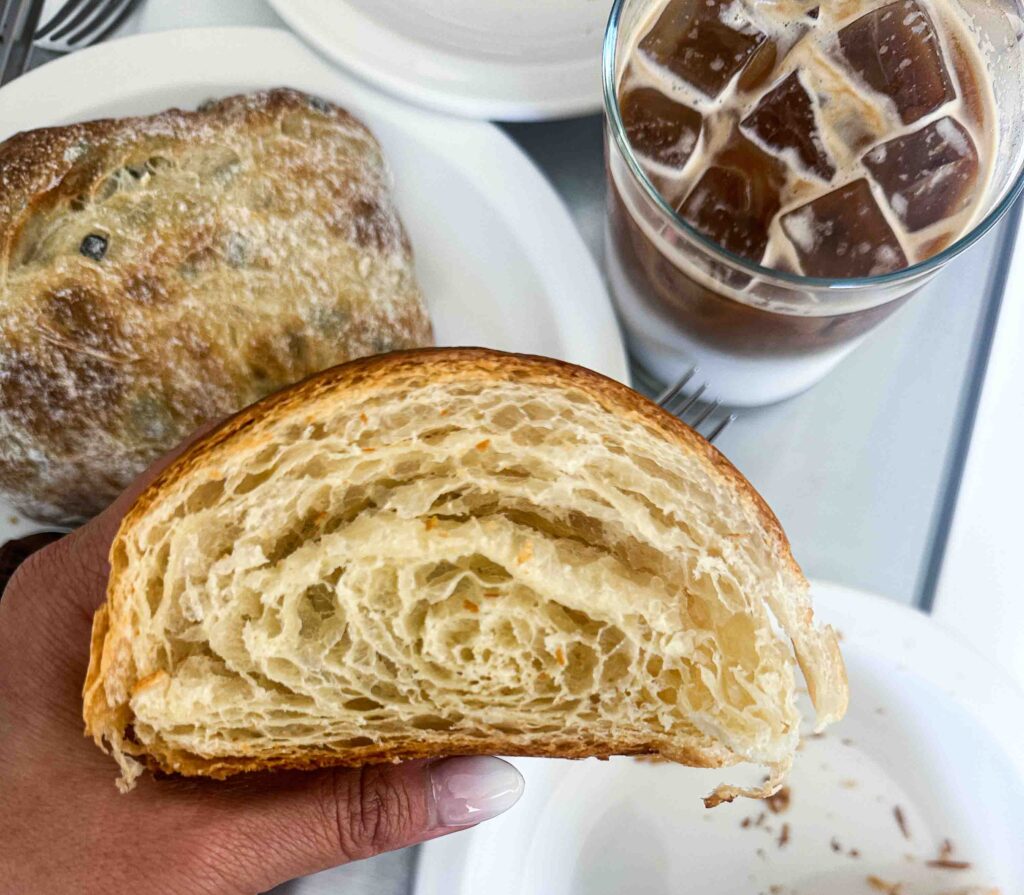
- Sindongyang Chinese Restaurant. Another OG veg-friendly spot, I love Sindongyang. I had their jjajangmyeon back in 2019 and actually sent it back, thinking they’d mixed up the order and given me a non-vegan version!!! That’s how AMAZING this place is! NGL–the owner is a bit of a curmudgeon who can get cranky quite easily, but push through your social anxiety and ask for the “green menu.” You’ll be happy you did!
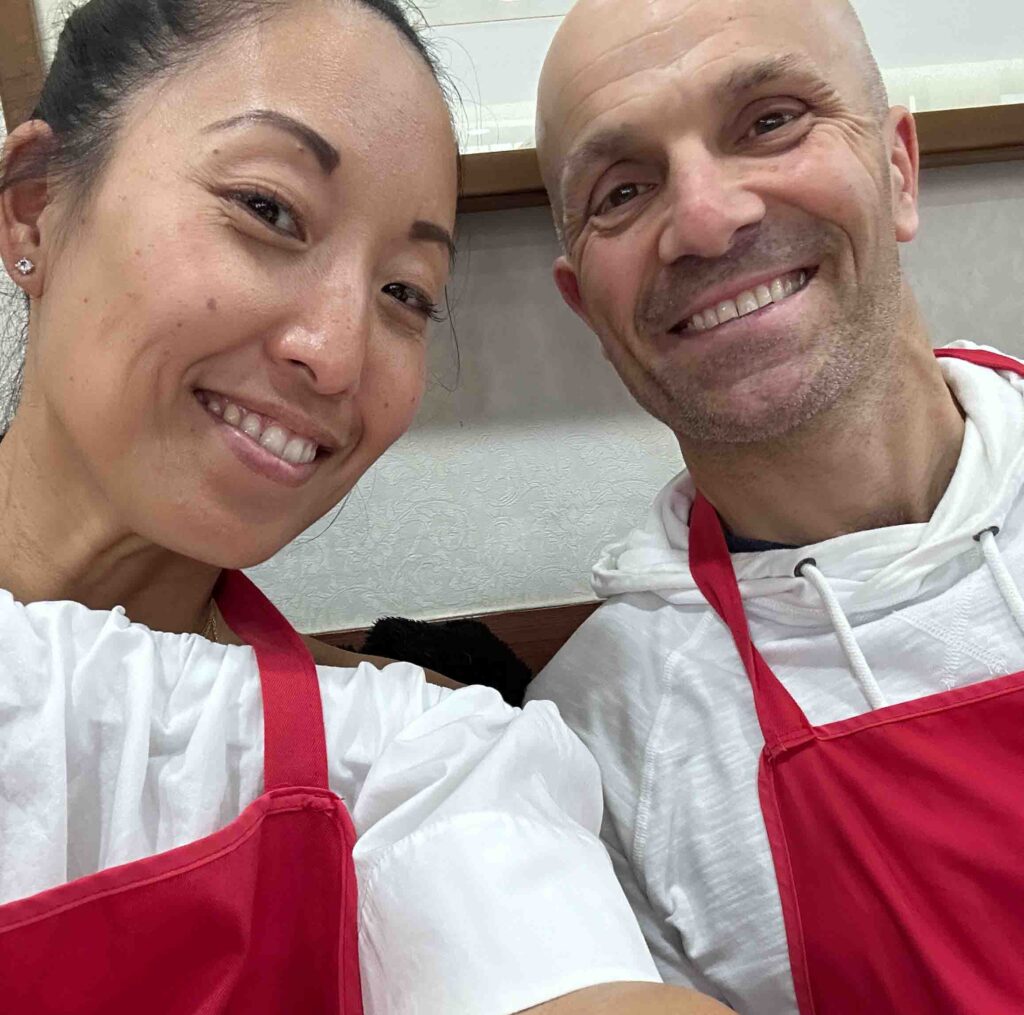
- Jihwaja. If you really want to eat like royalty, head over to Jihwaja. That’s their specialty–preparing Korean palace food. I was excited to discover (after a lot of internetting) that they have a separate vegan prie fixe menu. Each course will have you oohing and ahing; though, this vegan meal does come with a royal price tag, so save it for those extra special occasions!
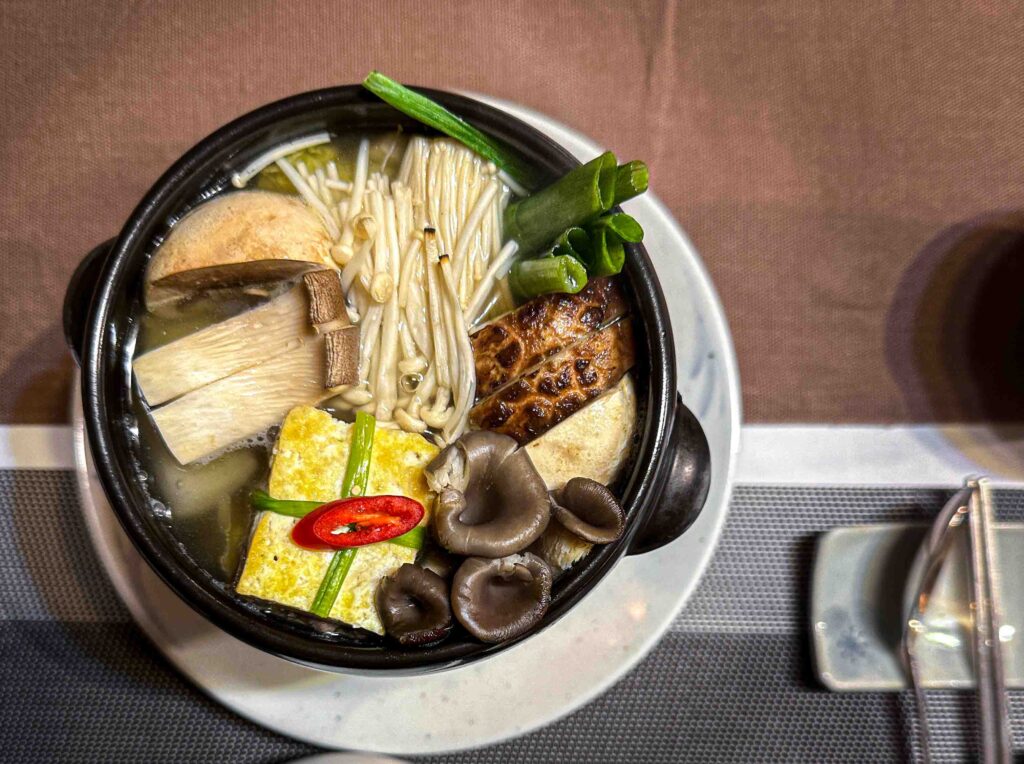
- Deokseongwon – Jeju. Our first stop in Jeju was a famous Chinese restaurant, known for its jjajangmyeon. After digging deep into Naver and deploying all the Korean I had at my fingertips, I got my digital hands on their menu, which featured a meatless and fish-free jjajangmyeon, sometimes referred to as “gahn jjajangmyeon.” When we ordered, our server referred to it as “chaeshik jjajangmyeon” and nodded as if it’s something they regularly prepare. It was the best jjajangmyeon I’ve had since going vegan!!!
The following are restaurants we tried and, while appreciative of their vegan options, didn’t find terribly memorable (or good):
- Maru Natural Kimbap. I wanted to love this little all-vegan bunshik style food stall in the middle of Insadong, but honestly… it is not the best representation of Korean food. They are clearly short-staffed and struggling to keep up with orders and I think this may impact the quality of their food. If you need something to tide you over during a shopping marathon in Insadong, this place will do. Otherwise, head over to some of the options above for a meal you can feel good about.
- Boccalino by The Four Seasons. Lest you think this post is sponsored by The Four Seasons-Seoul, I would not recommend their Italian eatery. It’s expensive and the food is not very memorable. This might be, in part, because Anthony and I have eaten really good vegan Italian food in Italy!! But it’s also because the restaurant suffers, a bit, from its own pretentiousness, forgetting that pricey menus and snow-white linens don’t necessarily translate into worthwhile service.
- Jinju Hoegwan. This was the kong guksu restaurant my father insisted on taking us to on our last day in Korea. It’s one of the most famous kong guksu shops in the country, boasting patrons like the Korean president. But my parents both found it really bland and didn’t like their kimchi (too sweet). I also found the noodles not to my liking and quite rich–especially with no acid to cut through the thick broth (the kimchi wasn’t vegan).
The following are recommendations we didn’t get to try (yet) from my friend, Won-suk Shin, a long time vegetarian and vegan who was born, raised, and now lives in Korea (he studied and worked in NYC for a bit, too):
- Alt A. A great all-vegan Korean Chinese-style restaurant in Itaewon. According to my sister-in-law, who did some sleuthing on Naver for me, many folks (including Won-suk) claim this place has the best vegan jjajangmyeon (black bean noodles) in Seoul.
- Maji.
- Little Gangster.
- byTOFU.
- Stylevegan. “Amazing tacos and pizzas”!
- Monk’s Butcher.
- Mother’s Table. “Homemade style restaurant with vegan options (about 6 items on the menu).”
- Plantude. These are restaurants owned and operated by my favorite tofu company, Pulmuone.
- Forest Kitchen. A fine dining, all vegan restaurant with a prix fixe menu.
- Legume.
Top 10-Tips On Traveling Vegan In Korea.
In sum, traveling as a vegan in Korea is hard–much harder than it might appear, at first glance. There aren’t a lot of foods in Korea that are “safely vegan.” Moreover, the average person living in Korea may not be adequately familiar with what you mean when you say “bee-guhn.” That said, the good news is that the number of restaurants that advertise vegan options are continuing to grow.
The following are my top-10 tips on traveling vegan in Korea:
- Download HappyCow. This app continues to helped me navigate all my travels, domestic and abroad. While it isn’t the only good resource out there, it’s definitely a good place to start.
- Download Naver Map. You can always toggle the language to English, set up an account, and start bookmarking all the spots you see when you type in “비건.” The other reason to download Naver? The hours are more accurate, the menu items more up to date, and it’s the only reliable map app that will tell you how long it will take to drive, cab, or walk somewhere (Google Maps will not).
- Don’t Be Afraid to Say “Bee-guhn.” It’s a newer word, but it’s definitely a part of the Korean lexicon now. If you’re in Seoul and particularly if you’re in a restaurant or hotel that caters to a non-Korean clientele, there’s at least a 50/50 shot they’ll know what you mean by “bee-guhn,” and if unsure, will at least ask you before throwing anchovies into your “vegan” stew. Or, better yet, learn a couple of helpful Korean phrases or save a photo of the card I made above, in case you run into an impassable language barrier!
- Avoid Modern Korean Bakeries. Tous Les Jours, Paris Baguette, and all the other modern Korean bakeries that don’t specifically offer a vegan menu rely heavily on butter and eggs. You’ll find little if anything you can eat there as a vegan. Save yourself the disappointment and find a solid vegan or vegan friendly cafe like Plant Cafe, Overte, or Leedorim OR head over to a traditional Korean bakery and treat yourself to an assortment of tteok!
- Stick to Vegan/Vegetarian Restaurants or Ones With Clear Labels. Walking into a traditional Korean restaurant that doesn’t have clearly labeled items will, unfortunately, test not only your Korean speaking skills, but also your patience. Many Korean restaurant owners are struggling to keep their restaurants afloat and have little time to answer questions like “do you add fish sauce?” “can you make the broth without anchovies?” “do you have a vegan option?” This is obviously a generalization, but, this was, in all candor, not just my own experience but also my parents’ (who always ask about vegan options, now, whenever they eat with me).
- Research Coffee Shops. Coffee culture in Korea is unlike anything I’ve ever witnessed–even in Rome. There are 5 cafes for every city block, stacked one on top of another. But unlike in the United States (or even in Italy), you cannot just walk into any ole’ coffee shop and expect to see plant-milk options. We made that mistake early on and realized you not only have to research whether they have vegan croissants, you also have to see whether they have vegan milks (though if they have the former, they will definitely have the latter).
- Use the Concierge Desk. You can do all the research you want beforehand, but you may still be surprised at the gems unearthed by your hotel’s concierge desk. Mine came back with a few vegan options I’d never come across on all my internet sleuthing! Not all concierge desks are created equal, but they’re there and your hotel rate helps to pay for their services. Use them!
- Uber Works in Korea! If you’re as terrified of foreign-taxi-use as I am (I never know whether you can hail them, whether you need to tip them, etc.), you can cut through some of this by downloading Uber. It isn’t as reliable as it is in the US, but it definitely got me and Anthony out of a jam (like on the way back from Overte!).
- Use Social Media. I don’t just mean watch all the #veganinkorea TikToks you can find. I mean, try and reach out to actual vegans in Korea–particularly native Koreans who are vegan. Veganism is still a budding community in Korea and, like I said, has far less stigma and negativity attached to it than in the US. As such, they’re a fairly welcoming group who are eager to share their knowledge. I connected with my friend Won-suk, a vegan I met through Twitter! And as evidenced above, he provided me with a plethora of options I’d have never discovered otherwise!
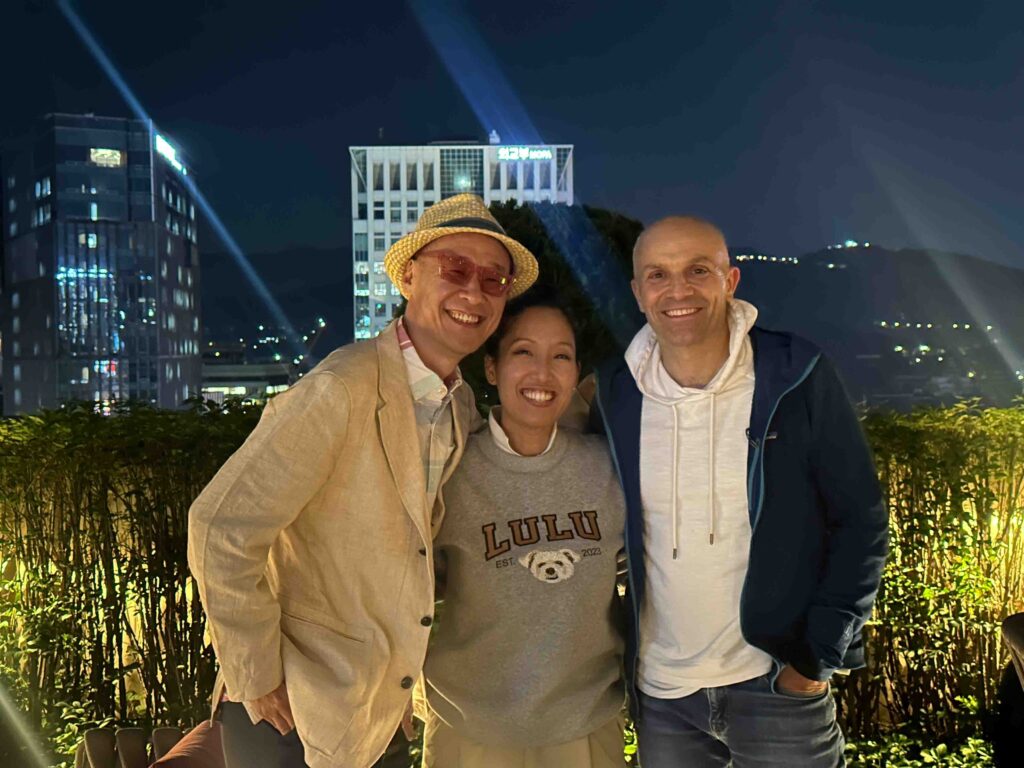
- It’s Not Just About Food!! I always have to remind myself that just because I travel somewhere, it doesn’t mean I automatically have to try every single vegan restaurant in the city. I used to plan all my trips around such-and-such vegan restaurant or this-and-that vegan ice cream shop, until I realized that this was a little strange and also, not that healthy! My stomach was always bloated and I was missing out on valuable time I could use to walk through various neighborhoods, visit a museum, go for a hike, or hang with relatives and friends. While good food is definitely a part of any good trip, Korea has so much more to offer than tteokbokki–don’t lose sight of that, whether you’re vegan or not!






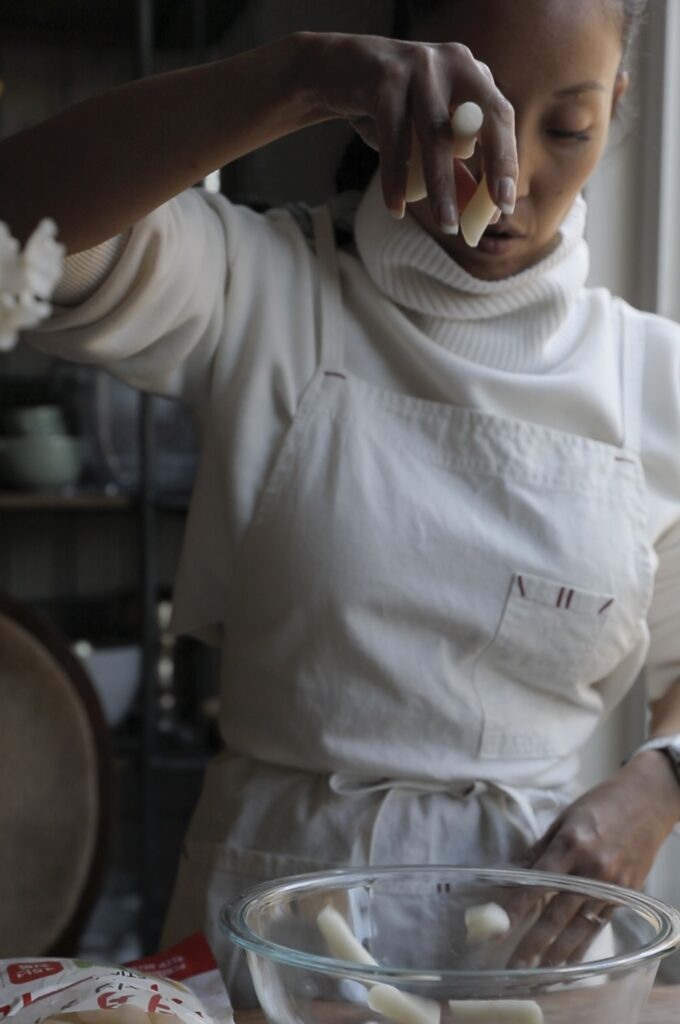
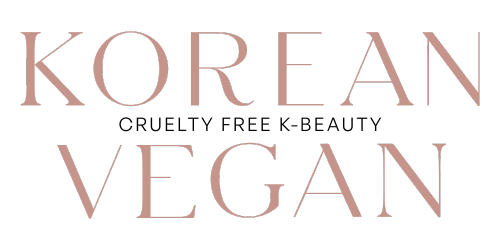

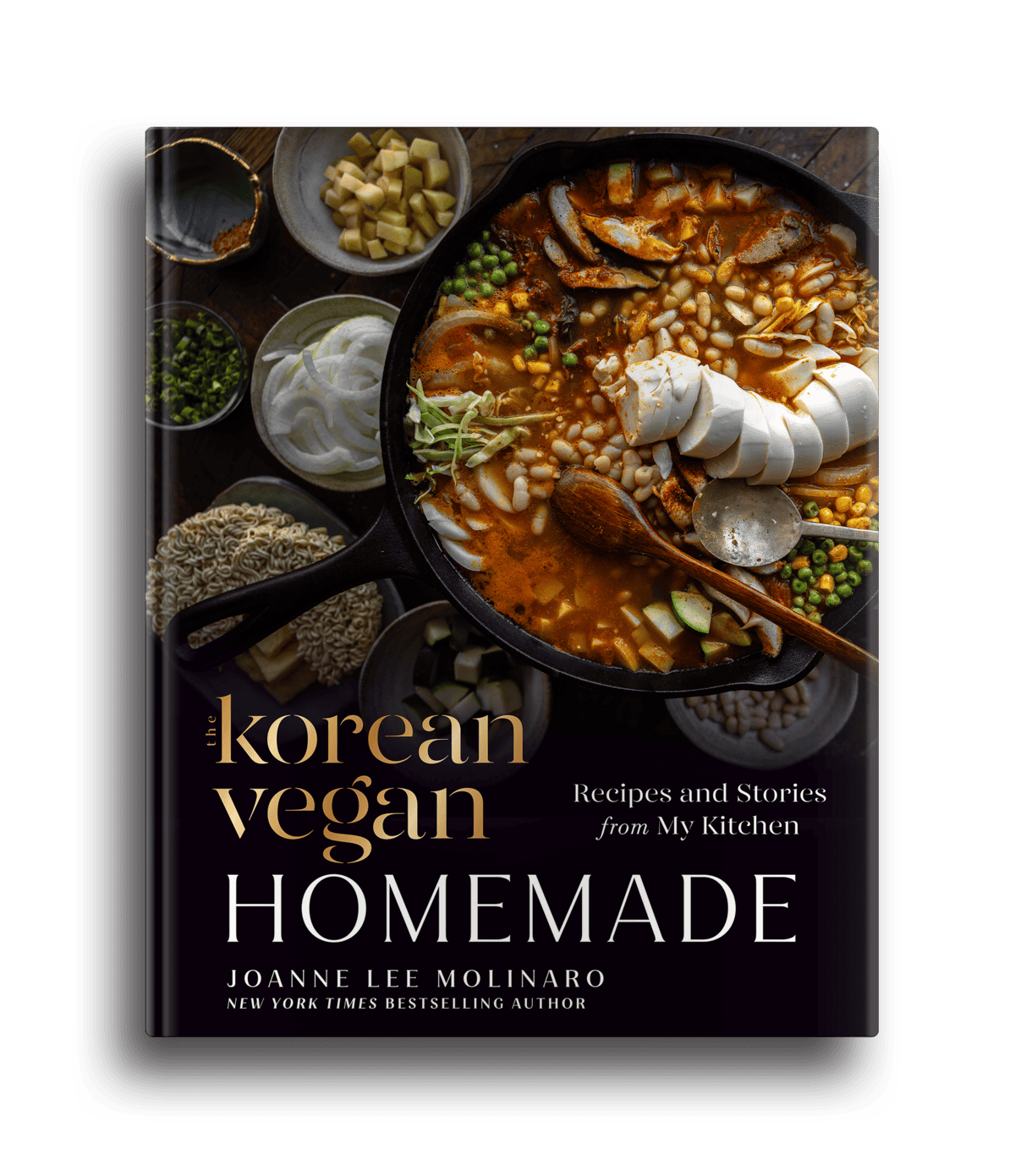
My dad is vegan and I was raise vegetarian. I ended up eating meat because of depression, blah blah, but I try to be as ethical as possible. My husband is Korean-American and panics at the mention of a meal sans meat. It’s quite comical, but I love him and I am working him to a diet with less meat. I have your cookbook and it’s amazing. Thank you for this! Were you inspired?! Any new recipes on the horizon?!
Any tips on finding gluten free menu items in Korea?
Most people have no idea what that even is, since it doesn’t seem to be a problem for most Koreans in Korea. I work 12 hour days at a 학원 and really don’t have time to cook.
I am a vegetarian but love your posts. I hope when I visit Korea next April food will not be an issue.
Hi Caroline! thank you so much! and yes–you will have a much easier time as a vegetarian: “chaeshik.” That said, you should still be careful to avoid fish sauce and anchovy broth!
This is such a fabulous and helpful post. Thank you, Joanne. I’m bookmarking it for October. I can’t wait to get back to Plant…we will have a birthday to celebrate and their cakes are so yummy—especially the blackberry pistachio one. Glad you had such a great trip. 🙂
Tammy, so glad you found this helpful and super excited for your trip in October!! Hopefully, that blackberry pistachio will still be on the menu!!!
You are so adorable and smart! Thank you for all the food close-ups as well as the people pictures. I went to Jeju Island for the first time a few years back with my mother, sister, her children and my children. Your descriptions of the island are poetic and so true. Anthony seems like a gem too! Thank you!
HAHAHA, thanks Unyong! My mom said almost the exact same things about me and this article! 🙂 Hope you get back to Jeju one day soon!
I’m going in the fall so this list was very helpful, thank you!!
I’m so glad!! I know you’ll have a wonderful time Lynda!
This Article was made for me ! Thank you so much !
I’m so glad this was helpful Mala!
Thanks for sharing Vegan in Korea. You have a nice template to follow. OMG, the vegan croissant ❤️!
that vegan croissant was EVERYTHING!!